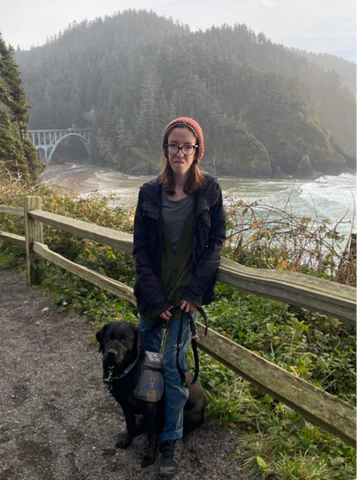When people hear that I camp "by myself"—which really just means without a human companion, since my dog Amara is always with me—they often say things like, “I’d be too scared to do that†or “Aren’t you afraid?†The truth is, I’m not really, at least not enough to stop me from going. Part of the reason is that I think people imagine something way more extreme than what I actually do—just a couple of nights at established campgrounds, usually with hosts, cell service, and within sight of my car. Still, I probably wouldn’t have felt comfortable doing this without first camping with friends, learning what to expect, and understanding my own limits. So far, all my dispersed camping trips have been with others, relying on their strength and knowledge of the area. No matter how you choose to camp, fear is something worth considering—and listening to. That’s why I always take a moment to reflect on it before heading out, just like I do at the start of every trip. In the woods or in nature, I find a kind of peace and quiet in my mind that I don’t get anywhere else. It feels like the trees, plants, sky, and earth are accepting of me in a way that built environments never are. But that same acceptance comes with an indifference that can be dangerous. Nature has a power that reminds us how fragile we are compared to bears, storms, rockslides, or falling trees. A healthy dose of fear is actually a good sign—it shows you’re aware of the risks. Checking the weather, wildfire risk, and road conditions before you go, and letting someone know where you’ll be and when you’ll return are simple steps that can make a big difference. Sometimes, even with all the preparation, you might feel uneasy. I’ve had moments on hikes where I got the creeps or where Amara seemed alert, so we just turned back. Maybe it was nothing—a chipmunk, a shadow, or just my imagination. Other times, there are more obvious reasons to leave early: it’s too hot, too cold, too buggy, or you forgot your water. Bailing on a trip isn’t a failure—it’s part of the experience. Plus, stories about outdoor mishaps are always more entertaining than the perfect ones. But there's another layer to fear that goes beyond personal experiences. You may have seen the trending question online: “Would you rather meet a man or a bear in the woods?†While it sounds like a lighthearted joke, it opens up a serious conversation about who feels safe, welcome, and comfortable in natural spaces. For many historically marginalized groups—BIPOC, queer individuals, disabled people, and women—rural and natural areas have long been places of danger, exclusion, and displacement. This history shapes the infrastructure we see today. In the Pacific Northwest, where Amara and I live, much of the park infrastructure—trails, picnic areas, bridges, and even forests—was built in the 1930s and 1940s by the Civilian Conservation Corps (CCC), a New Deal program that employed young men for manual labor. While I benefit from that work, it’s clear from the lack of railings, narrow stairs, and inaccessible paths that it wasn’t designed for people like me. Looking at old CCC posters, most of the figures depicted are young, white, muscular men—strong, confident, and always in powerful poses. These images, along with the historical exclusion of certain groups from public lands, shaped our perceptions of who belongs in nature and how they should interact with it. Understanding this history helps me recognize where my fears come from and how to respond to them. It also reminds me that as we work toward a more inclusive outdoors, we must do so with humility, respect for the land, its original inhabitants, and all those who call it home. Nature is wild, unpredictable, and beautiful—but it’s also a place where we must learn to coexist, not dominate. Hope to see you out there! _________________ About the Author: Hello! I’m Mary, and this is my amazing service dog, Amara. We live in Oregon and love hiking and camping. I’m not an expert, but I’d like to share some of the strategies and products that have worked (and haven’t) for us, in hopes that it might help you as you explore the outdoors. Hope to see you out there! Customized Toys,Customized Adhesive Toys,Drip Glue Toys,Cartoon Adhesive Toys DONGGUAN TETSUMET TECHNOLOGY CO.,LTD , https://www.tetsumet.com